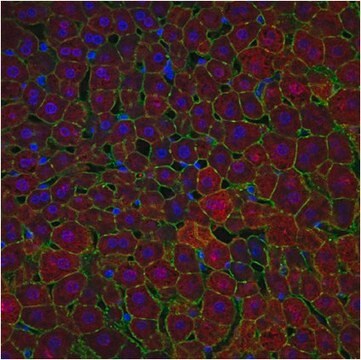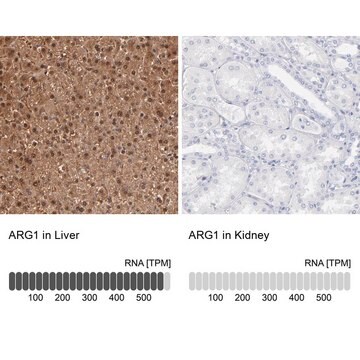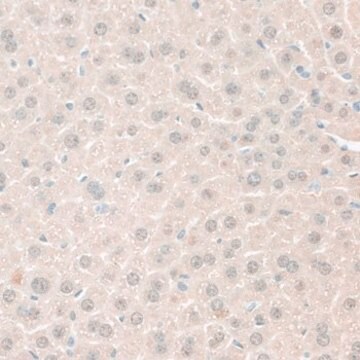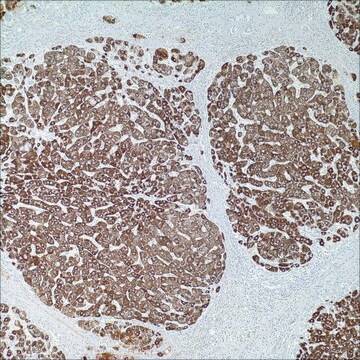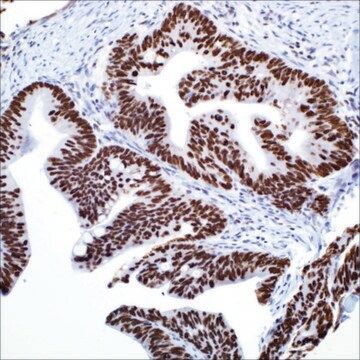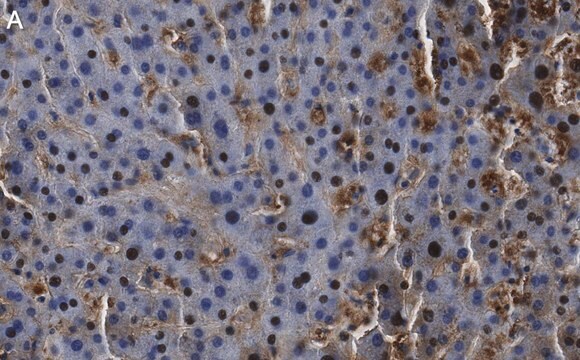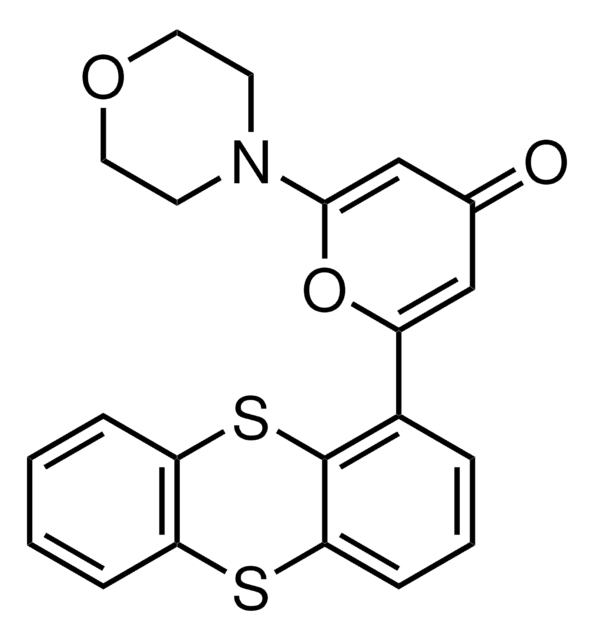推荐产品
生物源
rabbit
品質等級
100
500
共軛
unconjugated
抗體表格
culture supernatant
抗體產品種類
primary antibodies
無性繁殖
SP156, monoclonal
描述
For In Vitro Diagnostic Use in Select Regions (See Chart)
形狀
buffered aqueous solution
物種活性
human
包裝
vial of 0.1 mL concentrate (380R-14)
vial of 0.5 mL concentrate (380R-15)
bottle of 1.0 mL predilute (380R-17)
vial of 1.0 mL concentrate (380R-16)
bottle of 7.0 mL predilute (380R-18)
製造商/商標名
Cell Marque™
技術
immunohistochemistry (formalin-fixed, paraffin-embedded sections): 1:25-1:100
同型
IgG
控制
hepatocellular carcinoma, normal liver
運輸包裝
wet ice
儲存溫度
2-8°C
視覺化
cytoplasmic, nuclear
基因資訊
human ... ARG1(383)
一般說明
Arginase is a key metalloenzyme of the urea cycle responsible for the hydrolysis of L-arginine to L-ornithine and urea. Two main isoforms exist, arginase-1 and arginase-2, encoded by different genes and with different tissue distributions. The arginase-1 isoform is a cytosolic protein that is produced by normal liver tissue and is typically expressed in hepatocellular carcinoma. Arginase-1 (SP156) is used as an immunohistochemical marker to aid in the identification of hepatocellular carcinoma.
品質
 IVD |  IVD |  IVD |  RUO |
聯結
Arginase-1 Positive Control Slides, Product No. 380S, are available for immunohistochemistry (formalin-fixed, paraffin-embedded sections).
外觀
Solution in Tris Buffer, pH 7.3-7.7, with 1% BSA and <0.1% Sodium Azide
準備報告
Download the IFU specific to your product lot and formatNote: This requires a keycode which can be found on your packaging or product label.
其他說明
For Technical Service please contact: 800-665-7284 or email: service@cellmarque.com
法律資訊
Cell Marque is a trademark of Merck KGaA, Darmstadt, Germany
未找到合适的产品?
试试我们的产品选型工具.
从最新的版本中选择一种:
分析证书(COA)
Lot/Batch Number
A Wee
Cytopathology : official journal of the British Society for Clinical Cytology, 22(5), 287-305 (2011-07-19)
The role of fine needle aspiration (FNA) biopsy of the liver has evolved. Advances in imaging modalities have obviated the need for tissue confirmation in clinically classic hepatocellular carcinoma (HCC). The risks of needle tract seeding and haematogenous dissemination have
H B el-Serag
Clinics in liver disease, 5(1), 87-107 (2001-02-24)
The epidemiology of hepatocellular carcinoma (HCC) is characterized by marked differences between genders, ethnic groups, and geographic regions. These variations are explained by the nature, frequency, and time of acquisition of the major risk factors for cirrhosis--namely hepatitis B virus
Z W Zhu et al.
Gut, 48(4), 558-564 (2001-03-15)
Hepatocellular carcinoma (HCC) is a common malignant tumour worldwide, and its differential diagnosis from benign lesions of the liver is often difficult yet of great clinical importance. In the present study, we analysed whether glypican-3 is useful in differentiating between
Aileen Wee
CytoJournal, 2, 7-7 (2005-06-09)
The role of fine needle aspiration biopsy (FNAB) in the evaluation of focal liver lesions has evolved. Guided FNAB is still useful to procure a tissue diagnosis if clinical, biochemical and radiologic findings are inconclusive. Major diagnostic issues include: (i)
H Multhaupt et al.
Histochemistry, 87(5), 465-470 (1987-01-01)
Monoclonal antibodies against human liver arginase were raised in order to determine the exact distribution of arginase in human liver using a modified indirect unlabelled immunoperoxidase method. In normal human liver specific immunohistochemical staining was found in the cytoplasm of
我们的科学家团队拥有各种研究领域经验,包括生命科学、材料科学、化学合成、色谱、分析及许多其他领域.
联系技术服务部门